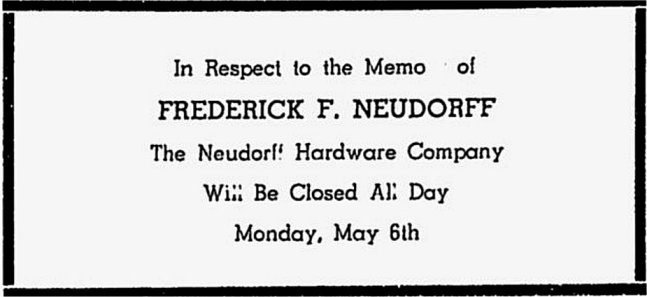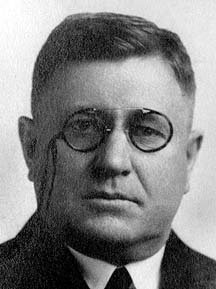This building was constructed in 1874 for St. Joseph's first newspaper, The St.
Joseph Gazette. The city editor for the Gazette at that time was a famous
Missourian, Eugene Field, who went on to become known for his prolific works as
"the children's poet."
Over the years the building was used for the manufacture & sale of agricultural
implements, carriages, saddles, tents and awnings, and for a time was used for
light manufacturing. The building is a good example of the type of commercial
building that made St. Joseph the wholesale mercantile center of the United States
during the latter half of the 19th century
In 1845, St Joseph Gazette was founded by William Ridenbaugh
In 1875, the Gazette newspaper office moved to this location
In 1875, Eugene Field served as the Gazette editor
Mr Field was married to local resident Julia Comstock
Some other businesses that were at this address include:
Queen City Carriage Company
Rossi Saddlery
St Joseph Tent & Awning
Bodyguard (maker of Firemen's clothing)
Appliance Man Rental
Queen City Carriage Company
Jacob Wickenhoeffer, born in Kur Hessem Germany in 1855, came to St Joseph in 1887 and
started the Queen City Carriage Company in this building.
His factory turned out various vehicles such as carriages, spring wagons, etc.
Contained within the building was a blacksmith shop, woodwork shop, paint shop, trimming room and sales rooms.
He made 2 grades of carriages, one that ranged from $185 to $300. His 2nd grade sold for $300 to $400.
Rossi Saddlery
Rossi Saddlery was established in 1892 at this address.
John Rossi was quite the name in saddles in the early 1900's.
Rossi was a supplier of leather products for the military during WWI
Mr Rossi was commissioned as a Captain in the ordnance department.
He supplied saddles, leather rifle slings, etc.
John Rossi was bought out by the Wyeth Company, who was a competitor at the time
In all of their ads in the leather and saddlery publications, there was never a mention of an address.
Their Saddlery Company Catalogue Number 5 contained 363 pages, it was printed in 1904.
It included illustrations and prices for horse equipment, supplies & saddlery
ST JOSEPH TENT & AWNING
St. Joseph Tent and Awning along with Bodyguard Manufacturing occupied this building for many years.
St. Joseph Tent & Awning consumed the entire 1st floor. The Bodyguard staff was located on the 2nd floor.
BODYGUARD MANUFACTURING
Bodyguard was a subsidary of St Joseph Tent and Awning. They were located on the 2nd floor.
There were ladies manning sewing machines and men manned a cutting table. They manufactured firemen
coats & pants. They also made leather covered steel insoles for the firemen's boots.
In 1963 & 1964, I worked part time after my college classes for Bodyguard making the steel insoles for
fireman boots & I also painted names on back of the fireman coats
(Building circa 1874)
Contributing building for:
NATIONAL REGISTER OF HISTORIC PLACES
Small Scale Commercial Block. Italianate influence.
Three story corner brick building with cornice removed.
Second and third stories divided into two bays by raised center pier.
Third story with three very tall round arch 4/4 sash per bay with blind arch transoms, limestone round arch hoods with keystones, and spandrels
with panels. Second story with three large rectangular windows with brick flat arches
with drops per bay infilled with concrete and glass block, but openings maintained. Part
of original storefront appears to remain under present shake-shingle "mansard roof" canopy
and vertical wood siding, as suggested by quoins exposed on southeast corner.
Details return on south elevation; entry set in "Gibbsian" surround with flanking quoins and arch
above with voussoirs alternately raised. Similar rear (west) historic wing with dentiled
cornice; some 6/6 unadorned windows remain intact.
The 1991 survey lists this building as "contributing" on the National Register of Historic Places
It is in the South Fourth Street Historic District
Appliance Man Rentals occupied this building in later years and has remodeled the building
There has been much discussion about whether to raze or keep this historic structure
|

 1
1
 2
2
 3
3
 4
4
 1
1
 2
2
 1
1
 2
2
 3
3
 4
4

 1
1
 2
2
 3
3
 4
4
 5
5


 1
1
 2
2
 3
3
 4
4
 5
5
 1
1
 2
2
 1
1
 2
2
 1
1
 2
2
 3
3

 1
1
 2
2
 3
3
 4
4
 5
5
 1
1
 2
2
 3
3
 4
4
 5
5
 6
6
 7
7
 1
1
 2
2
 3
3
 4
4
 5
5
 1
1
 2
2
 3
3
 4
4



 1
1
 2
2
 3
3
 4
4
 1
1
 2
2
 3
3
 4
4
 5
5
 1
1
 2
2
 3
3


 1
1
 2
2
 3
3
 4
4
 5
5
 6
6
 7
7
 8
8
 9
9
 10
10
 11
11
 12
12
 13
13
 14
14
 15
15
 16
16
 1
1
 2
2
 3
3


 1>
1>
 2
2
 1
1
 2
2
 3
3
 4
4
 5
5
 6
6
 7
7
 8
8 9
9

 1
1
 2
2
 1
1
 2
2
 3
3
 3
3
 1
1
 2
2
 3
3
 1
1
 2
2
 3
3
 4
4
 5
5
 6
6
 1
1
 2
2
 1
1
 2
2
 3
3
 1
1
 2
2
 3
3
 4
4
 5
5
 6
6
 1
1
 2
2
 3
3
 4
4
 5
5
 6
6
 7
7
 1
1
 2
2
 3
3
 4
4
 5
5
 6
6
 7
7
 8
8


 1
1
 2
2
 1
1
 2
2
 1
1
 2
2



 1
1
 2
2
 1
1
 2
2
 3
3

 1
1
 2
2
 3
3




 1
1
 2
2
 3
3
 1
1
 2
2
 3
3
 1
1
 2
2
 1
1
 2
2
 3
3

 1
1
 2
2


 1
1
 2
2
 3
3
 4
4


 1
1
 2
2






 1
1
 2
2
 3
3
 1
1
 2
2
 3
3
 4
4
 5
5
 6
6
 1
1
 2
2
 3
3
 4
4
 5
5
 6
6
 7
7
 8
8
 9
9
 10
10
 1
1
 2
2
 1
1
 2
2
 3
3
 4
4
 5
5
 6
6
 7
7


 1
1
 2
2
 3
3
 4
4
 5
5
 6
6
 1
1
 2
2
 3
3
 4
4
 5
5

 1
1
 2
2
 3
3
 1
1
 2
2
 1
1
 2
2
 1
1
 2
2
 3
3
 4
4
 5
5
 6
6
 7
7
 8
8
 1
1
 2
2



 1
1
 2
2
 1
1
 2
2
 3
3
 4
4
 5
5
 6
6
 7
7
 1
1
 2
2
 3
3
 4
4







 1
1
 2
2
 3
3
 4
4
 5
5

 1
1
 2
2
 3
3
 4
4
 5
5



